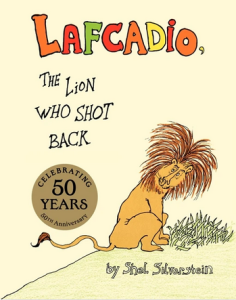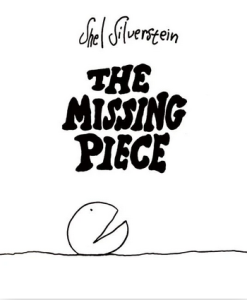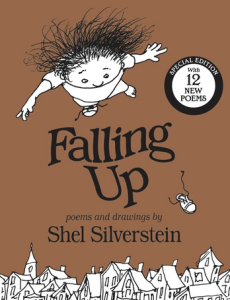“I never planned to write or draw for kids. It was Tomi Ungerer, a friend of mine, who insisted … practically dragged me, kicking and screaming, into [editor] Ursula Nordstrom’s office. And she convinced me that Tomi was right, I could do children’s books.” — Shel Silverstein
 The first time I bumped into the work of Shel Silverstein, he was an aging Lothario whose poems and distinctive line drawings and cartoons graced the pages of Playboy magazine. I was a teenager, and I read this glossy monthly for the quality short stories and lifestyle articles they published. I so treaured this bastion of 20th century literature and taste that I hid my copies of the magazine in a box in my closet so they would not be accidentally lost or destroyed. Silverstein, long, rangy, bald, with a chin-lining beard, was also a songwriter (and folk singer) who provided hits for Johnny Cash and Dr. Hook. However, in true Renaissance-man style, that wasn’t the end of his talents. He wrote books for children too!
The first time I bumped into the work of Shel Silverstein, he was an aging Lothario whose poems and distinctive line drawings and cartoons graced the pages of Playboy magazine. I was a teenager, and I read this glossy monthly for the quality short stories and lifestyle articles they published. I so treaured this bastion of 20th century literature and taste that I hid my copies of the magazine in a box in my closet so they would not be accidentally lost or destroyed. Silverstein, long, rangy, bald, with a chin-lining beard, was also a songwriter (and folk singer) who provided hits for Johnny Cash and Dr. Hook. However, in true Renaissance-man style, that wasn’t the end of his talents. He wrote books for children too!
He called himself Uncle Shelby, and in 1963 HarperCollins released the first of a series of Uncle Shelby’s tales that would charm children and parents for over 40 years. The earliest book for discussion, his first, is Lafcadio: The Lion Who Shot Back. It seems as though the title tells the whole story. But does it? The hero of the tale doesn’t even have a name when he is introduced. He’s simply a lion, living in the jungle with a bunch of other lions: “if he did have a name … it … wasn’t … like Joe or Ernie … it was more … like … Grograph or Ruggrrg or Grmmff or Grrrrr.” He is awakened by the sound of a gun. The great white hunter confronts our lion and, after a brief negotiation in which the lion volunteers to act as a lion skin rug in front of his fire without all the shooting, discovers that the man forgot to load his gun. This proves to be a costly mistake as the lion eats the hunter and takes possession of his rifle. After some practice he finds himself able to shoot quite well, and begins a collection of “hunter skin rugs.” He is taken to the city by an entrepreneur who names him Lafcadio and makes him a star. How does it end? Well, that would be cheating. Uncle Shelby spins a clever and playful yarn. Suffice it to say you’ll be pleasantly surprised.
(HarperCollins, 1963)
A Giraffe and a Half followed the next year. It’s an imaginative example of one of those add and subtract prose poems that children find so appealing. I should mention that Silverstein’s books are all filled with his quaint and humourous pen and ink drawings to illustrate the tales. In this volume, a little boy starts with a giraffe — stretches him by half — puts on a hat in which resides a rat — dresses him in a suit that looks rather cute — well, you get the idea. About halfway through he starts removing the items until at the end of the book there’s a little boy with a giraffe. The rhyming and juxtaposition are fun and entertaining. It’s not rocket science, but then it doesn’t take rocket science to entertain a 5 or 6 year old. We road tested these stories on my wife’s kindergarten class … and teacher got a laugh too!
(HarperCollins, 1964)
 The Missing Piece is a brief fable about a circle with a piece missing (as you might imagine). Dissatisfied with life as an incomplete sphere he rolls clumsily along trying to assimilate many and varied pieces and having adventures. It all comes down to not being happy with the way you are. Sound familiar? Uncle Shelby provides a sly and satisfying conclusion, which should keep everyone happy, except for the real stick-in-the-mud out there. The drawings are primitive and absolutely delightful.
The Missing Piece is a brief fable about a circle with a piece missing (as you might imagine). Dissatisfied with life as an incomplete sphere he rolls clumsily along trying to assimilate many and varied pieces and having adventures. It all comes down to not being happy with the way you are. Sound familiar? Uncle Shelby provides a sly and satisfying conclusion, which should keep everyone happy, except for the real stick-in-the-mud out there. The drawings are primitive and absolutely delightful.
(HarperCollins, 1976)
While The Missing Piece is, well, “missing” from the first book, it is (dare I say it?) the pièce de resistance of the second volume. The Missing Piece Meets the Big O is an equally charming fable teaching a different (but every bit as important) lesson. The Missing Piece shows us that we can be happy just the way we are while … Meets the Big O teaches us that change is not only possible, but sometimes is as healthy as it is inevitable. These two complementary books are my favourites of this Silverstein collection.
(HarperCollins, 1981)
 The final book is an anthology of unrelated poems and drawings entitled Falling Up. Silverstein understood the child’s mentality. He knew to avoid the sentimentality and treacle which pervades the weakest of children’s literature. He understood the young person’s fascination with jokes and worms and mice and bodily functions, and the edge that is often required to keep kids interested.
The final book is an anthology of unrelated poems and drawings entitled Falling Up. Silverstein understood the child’s mentality. He knew to avoid the sentimentality and treacle which pervades the weakest of children’s literature. He understood the young person’s fascination with jokes and worms and mice and bodily functions, and the edge that is often required to keep kids interested.
“I tripped on my shoelace
and I fell up—[high in the sky ’til]
…it got me so dizzy
when I looked around,
I got sick to my stomach
and I threw down.”
You get the idea? A sneaky cousin goes for a ride in a washing machine; a dancing bear escapes from a county fair; the furniture got broke — HOW?
“The hand of the clock
punched the foot of the bed,
so the foot of the bed
kicked the seat of the chair,
so the seat of the chair
sat on the head of the table…”
And on it went until nothing was left but “sawdust and springs.” Brilliant and hilarious, and lots of fabulously funny drawings to illustrate the poems.
(HarperCollins, 1996)
Silverstein (who died of a heart attack in 1999) was much more than the aging Lothario who was Hef’s right-hand man. He was more than the singer-songwriter who was “being swallowed by a boa constrictor,” or found himself on “the cover of the Rolling Stone.” He was a gifted and sensitive author of books for young people who managed to write in a way that would entertain parents and kids alike. So that no one would get that sinking feeling when their little girl says, “Read …the Big O again, Daddy.”
Thanks, Uncle Shelby.
